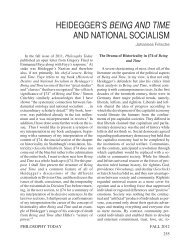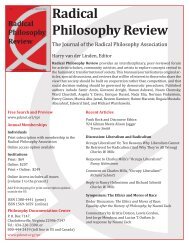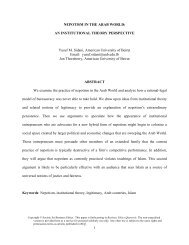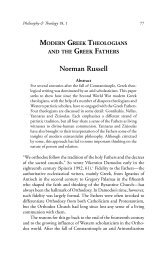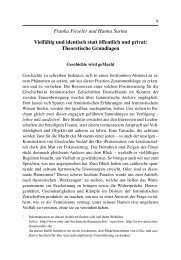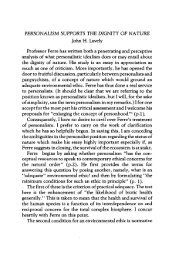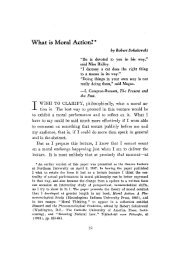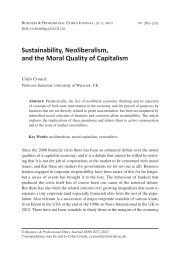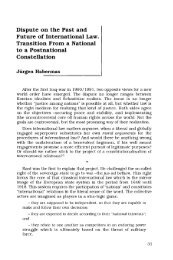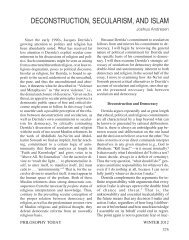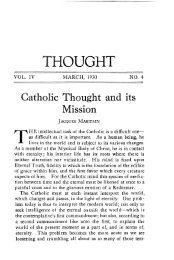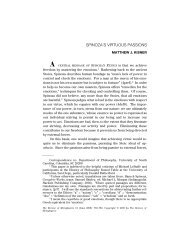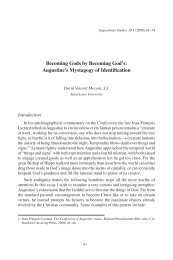Perverted Conversions: - Philosophy Documentation Center
Perverted Conversions: - Philosophy Documentation Center
Perverted Conversions: - Philosophy Documentation Center
You also want an ePaper? Increase the reach of your titles
YUMPU automatically turns print PDFs into web optimized ePapers that Google loves.
<strong>Perverted</strong> <strong>Conversions</strong>:<br />
Sovereignty, the Exception, and the<br />
Body at Abu Ghraib<br />
Rachel Walsh<br />
Abstract: This paper seeks to examine the images and<br />
discourses that have allowed for the declaration of the<br />
state of exception and the use of sovereign power. Examining<br />
the Abu Ghraib prison photographs as iconic<br />
emblems of the civilizational discourses that allow for<br />
exercises of sovereign power, I argue that these photographs<br />
articulate a dual interpellation of the Islamic<br />
Other as the terrorist/uncivilized Other and the viewer<br />
as a normative, national subject. I identify this moment<br />
as a perverted conversion in which the Islamic Other is<br />
hailed as one who necessitates an imperial crusade yet<br />
whose uncivilized state undermines the efficacy of that<br />
crusade.<br />
These are two distinct forms of normative power: one operates through<br />
producing a symbolic identification of the face with the inhuman,<br />
foreclosing our apprehension of the human in the scene; the other works<br />
through radical effacement, so that there never was a human,<br />
there never was a life, and no murder has, therefore, ever taken place.<br />
— Judith Butler, Precarious Life: The Powers of Mourning and Violence<br />
© Radical <strong>Philosophy</strong> Review volume 10, number 2 (2007) 133–148
— 134 —<br />
Rachel Walsh<br />
• • •<br />
. . . torture torture video panopticon prisoners speak digitally on cell<br />
phones home teleprompting images rosie is riveted torture torture<br />
woman’s place is in the house of horrors howling we have met the<br />
Frankenstein monster and she is us torture torture me rollin over human<br />
rights gangstah style meanwhile back at the ranch the branding iron’s on<br />
fire torture torture hard to define but i known it when i obscene it . . .<br />
— Evie Shockley, “a thousand words”<br />
In the almost four years that have passed since the publication of the Abu Ghraib<br />
prison photographs, the images and the methods of torture at Abu Ghraib have<br />
obtained an iconic status, serving alternately as the disavowed but persistent trademark<br />
of the Bush administration’s reign, a guidebook for the television show 24,<br />
and an appropriated sign that for many Iranians and Iraqis defines and indexes<br />
the “triumph” of Western democracy abroad. The images, so grossly staged and<br />
deliberately orchestrated, depict the reduction of bodies to texts that are made to<br />
signify a national narrative of the sovereign vs. the Islamic/terrorist Other. Yet, they<br />
also reveal and can be situated within a larger narrative of the Enlighten(ed)ment<br />
West’s construction of the pre-modern yet treacherously post-modern Islamic Other.<br />
I. The Limitations of Secular Liberalism: Icons of Violence and<br />
Civilizational Speech Acts<br />
This century has been inaugurated by a post-Enlightenment crisis that has exposed the<br />
limitations of a secular, Euro-American liberalism. This liberalism, as Wendy Brown<br />
observes, extends cultural tolerance (a term that maintains a colonial relationship<br />
between the Western subject who tolerates and the cultural Other who is tolerated)<br />
only to those who do not insist upon their difference from a secular liberalism. Under<br />
the auspices of a universal humanism, Western liberalism denies the civilizational<br />
discourses and their accompanying imperial politics that secure the positions of the<br />
tolerant Western subject and the irrational, cultural Other. 1 Yet a cursory inventory<br />
of recent instances of Euro-American speech acts reveals how these positions are<br />
discursively produced and performed. Although more liberal journalists decry the<br />
fact that the terms “Islam” and “fundamentalism” and “terrorism” have been inextricably<br />
linked, many American and European journalists were perplexed by the riots<br />
that ensued after caricatures of the Prophet Mohammed were published in Dutch<br />
1. Wendy Brown argues, in Regulating Aversion: Tolerance in the Age of Identity and Empire<br />
(Princeton: Princeton University Press, 2006), that the discourses of tolerance mask<br />
imperial politics by marking the Other as the subject with culture, while Western powers<br />
who tolerate are posited as neutral entities without culture.
<strong>Perverted</strong> <strong>Conversions</strong><br />
• • •<br />
— 135 —<br />
newspapers. In an open letter to Iranians and “fundamentalists,” David Brooks of the<br />
New York Times declared, “Our mind-set is progressive and rational. Your mind-set<br />
is pre-Enlightenment and mythological,” 2 but neglected to consider the political<br />
connotations of the Iranian protests. Similarly, President Jacques Chirac’s paternal<br />
assurances to French Muslims that “they were all children of France” were nullified<br />
by the postcolonial realities of socioeconomic disenfranchisement, police brutality,<br />
and the prohibition against students wearing the hijab in French schools. Meanwhile,<br />
Tony Blair declared that the wearing of a full hijab is a separatist gesture that upsets<br />
the balance between multiculturalism and assimilation that the people (read: white,<br />
middle-class British citizens) want. 3 And more recently, Republican Virgil Goode<br />
of Virginia warned his fellow Congress members that if they did not vote for<br />
the escalation of the troops, American coins would soon read “In Mohammed We<br />
Trust.” Goode’s remarks were later, perniciously, echoed by Rudy Giuliani, who, in<br />
the Republican candidate debates, decried the democrats’ failure to mention “Islamic<br />
terrorism.” 4<br />
While these notably post-Abu Ghraib speech acts possess and portend their own<br />
specific socio-historical valences that should not be neglected or consolidated, I<br />
constellate them here to show how they are indicative of a continuing discursive<br />
production of the “Islamic Other” or even simply “Islam,” signifiers that, as both<br />
Wendy Brown and Edward Said have argued, elide the distinctions between ethnicity,<br />
nationality, religion and culture, ultimately serving as a Western, and more<br />
specifically American, cultural shorthand for oil, terrorism and pre-modern religious<br />
difference. 5 Thus, those whose bodies cannot be incorporated into the bourgeois,<br />
national body — the poor, disenfranchised Muslim immigrants in France or those<br />
who insist upon their religious difference, the young women who choose to wear the<br />
full hijab in Britain, or those who must be positioned as a threatening presence to the<br />
national body in order for the national body to exist — the prisoners of Guantánamo,<br />
Abu Ghraib, and the U.S.’s secret prisons — come to signify a monolithic Islamic<br />
Other. The Islamic Other is hailed through these national speech acts and imperial<br />
policies as the terrorist Other, the racial Other, and the religious Other. As Brown<br />
persuasively argues, within a discourse of secular liberalism, the Islamic Other is<br />
one who is a culture and whose actions are governed solely by cultural and religious<br />
2. David Brooks, “Drafting Hitler,” New York Times, February 6, 2006, p. 27.<br />
3. Alan Cowell, “Blair Criticizes Full Islamic Veils as ‘Mark of Separation’,” New York Times,<br />
October 18, 2006, p. 5.<br />
4. “Transcript: The Republican Candidates Debate,” New York Times, August 5, 2007, at<br />
www.nytimes.com/2007/08/05/us/politics/05transcript-debate.html [accessed August 23,<br />
2007].<br />
5. Brown, Regulating Aversion; Edward Said, Covering Islam: How the Media and the<br />
Experts Determine How We See the Rest of the World (New York: Vintage, 1997).
— 136 —<br />
Rachel Walsh<br />
• • •<br />
mandates rather than political concerns. 6 Discursively spectralized in the Abu Ghraib<br />
photographs, the Islamic Other is painfully staged as one whose shame is a contemptible<br />
sign of their uncivilized state, and as one who must be punished with<br />
the cultural edicts that they are presumed to be solely governed by.<br />
I argue that images of Abu Ghraib are egregious and concentrated emblems<br />
of civilizational discourses already in circulation, particularly in the U.S. and to a<br />
lesser degree in the former colonial European nations. Indeed, Abu Ghraib is framed<br />
by a larger narrative of flawed, post-9/11 multicultural humanism, which as David<br />
Palumbo-Liu argues, is “a rearticulation of civilizational thinking along the axis of<br />
developed capitalist states.” 7 We are all human; we are all different — some are just<br />
more different and less human than others.<br />
The photographs of Abu Ghraib continue to haunt us, and should continue<br />
to haunt us, not because they show that this familiar refrain has suddenly been<br />
implemented as the U.S.’s foreign policy. Such an assertion would be both historically<br />
inaccurate and would suggest that the exercise of power precedes the ideology.<br />
Instead, the photographs expose how civilizational discourses allow for, and indeed<br />
help create, the legal and ethical vacuum in which sovereign power can be exerted<br />
against individuals whose bodies, racially, ethnically, and culturally, were never<br />
thought of as human to begin with. The effacement of the prisoners that occurs<br />
throughout the photographs, most pronouncedly with the figures of the hooded<br />
men, is preceded by a prior effacement. Judith Butler observes, “Those who remain<br />
faceless or whose faces are presented to us as so many symbols of evil, authorize<br />
us to become senseless before those whose lives we have eradicated, and whose<br />
grievability is indefinitely postponed.” 8 If the photographs are jarring it is because<br />
they disrupt that prolonged postponement and force the viewer to consider how<br />
this prior effacement (configuring all Arabs as cultural and religious Others, the<br />
failure to fully account for the deaths of Arabic citizens, Palestinians, Afghanstanis,<br />
Iraqis) produces the effacement and the simultaneous vulgar ventriloquization of<br />
“Islam” depicted in the photographs.<br />
In what follows, I examine the grossly aestheticized conversion in which the<br />
humanity of the Iraqi prisoners is disavowed and their bodies are reduced to<br />
caricaturized figures of the Islamic Other who forever necessitates, yet denies the<br />
efficacy of, American imperialism. Reading this perverse conversion as an insidious<br />
culmination of medieval sovereign exercises of power over the body and what Foucault<br />
6. Brown, Regulating Aversion, p. 151.<br />
7. David Palumbo-Liu, “Multiculturalism Now: Civilization, National Identity, and Difference<br />
Before and After September 11th,” Boundary 2 29, no. 2 (2002): p. 114.<br />
8. Judith Butler, Precarious Life: The Power of Mourning and Violence (New York: Verso<br />
Books, 2004), p. xviii.
<strong>Perverted</strong> <strong>Conversions</strong><br />
• • •<br />
— 137 —<br />
has identified as the modern turn towards the rehabilitation of the interior or the<br />
soul, I argue that the acts of torture at Abu Ghraib perform and are the products of<br />
a civilizational ideology that relies upon the impossibility of civilizing and rehabilitating<br />
the Islamic Other.<br />
Participating in this discourse, the photographs, while signaling what Giorgio<br />
Agamben identifies as the state of exception, force us to consider how both the use<br />
of sovereign violence and the state of exception in which that violence erupts are<br />
normative and dependent upon the cultural norms engendered by the “West and<br />
Islam” binary. We must consider how the “culturally specific” methods of torture<br />
in the Abu Ghraib photographs relate to a growing tendency in the U.S. to think of<br />
all Arab peoples as Islamic Others who are ruled by their cultures. Departing from<br />
Susan Sontag’s declaration that “the photographs are us” 9 (and more pointedly, the<br />
U.S.), I argue that while the photographs contain the signature of the sovereign, this<br />
signature is countersigned by civilizational discourses that, in designating the Islamic<br />
Other as one who is outside of an Enlightenment idea of the human, abandons the<br />
Islamic Other to a performative violence.<br />
II. Sovereignty, the Exception, and Knowledge Production on the<br />
Imperial Mission<br />
The imperial crusade that has become the Occupation of Iraq has been predicated<br />
on, as many scholars have remarked, a Schmittian algebra in which the state of<br />
exception enables the sovereign’s exercise of power. As Carl Schmitt famously<br />
declared in Political Theology, the state of exception and sovereignty are inextricably<br />
linked and define one another: “It is precisely the exception that makes relevant the<br />
subject of sovereignty, that is, the whole question of sovereignty. . . . [F]or it is he<br />
who must decide whether the constitution needs to be suspended in its entirety.” 10<br />
The exception, to rehearse Schmitt’s formulation, allows for or “makes relevant”<br />
the use of sovereign power, but the sovereign must first determine or create the state<br />
of emergency that requires the suspension of laws. As James Andreas Manos has<br />
persuasively argued, “this is a decision that places bodies outside of the political and<br />
at the same time secures the political, the national body, the national identity.” 11<br />
Using the figure of the Islamic Other to invoke the state of exception, the Bush<br />
administration has established a geopolitical map of exception, asserting that the<br />
9. Susan Sontag, “Regarding the Torture of Others,” The New York Times, May 23, 2004<br />
sec. 6, pp. 25–28.<br />
10. Carl Schmitt, Political Theology: Four Chapters on the Concept of Sovereignty, trans.<br />
George Schwab (Cambridge, Mass: The MIT Press, 1985), pp. 6–7.<br />
11. James Andreas Manos, “Homeland Insecurity and Bodies Born of Crisis” Radical<br />
<strong>Philosophy</strong> Review 7, no. 2 (2004): p. 145.
— 138 —<br />
Rachel Walsh<br />
• • •<br />
very location of the prison camps (outside the geographical body of the nation) and<br />
the extraordinary nature of the enemy combatants exceed the scope of the Geneva<br />
Conventions and allow for the suspension of habeas corpus.<br />
Yet the state of exception and the sovereign are less dependent upon the<br />
suspension of law, and more dependent upon the norms which already place certain<br />
bodies “outside of the political,” and which, consequently, easily assume the force<br />
of law as the law is suspended. In Judith Butler’s discussion of the resurgence of<br />
sovereignty in contemporary American politics, she observes that the re-emergence<br />
of sovereignty and the accompanying state of exception occurs in tandem with what<br />
Foucault identified in his later writings as governmentality, a form of power that<br />
operates through discourses and institutions but is never formally legitimated<br />
through established channels of authority. As Butler notes:<br />
The suspension of rule of law allows for the convergence of governmentality<br />
and sovereignty. . . . The state is neither identified with<br />
the acts of sovereignty nor with the field of governmentality, and<br />
yet both act in the name of the state. Law itself is either suspended,<br />
or regarded as an instrument . . . in constraining and monitoring a<br />
given population. 12<br />
Butler continues her discussion by noting that sovereign power is mainly exercised<br />
through “petty sovereigns” who, being affiliated with the bureaucracy rather than<br />
elected offices, wield their powers at their discretion. While Butler uncharacteristically<br />
makes only a passing reference to norms in her discussion of sovereign power and<br />
the suspension of law (she notes that the actions of petty sovereigns are obviously<br />
“conditioned”), her formulation invites an elaboration of how governmentality,<br />
which lends itself to sovereignty, both governs and is constituted by norms. For if<br />
governmentality is mainly characterized by its discursive and strategic (rules not laws)<br />
modalities of power, then that leads to the question: which discourses and norms<br />
allow for the suspension of law and subsequently come to rule in that lawless space?<br />
Agamben’s interventionist reading of Schmitt also invites these questions. In<br />
State of Exception he notes, just as Butler does, that the state of exception is more<br />
normative than exceptional, in terms of both the regularity with which it occurs and<br />
the means by which it is declared. Repeatedly punctuating the histories of European<br />
and American democracies, the state of exception emerges again and again during<br />
times of war as an indeterminate space in which the extraordinary facts demand the<br />
suspension of the law and acquire the force of law. As the “facts on the ground”<br />
that constitute the state of exception usurps the law, they signal the merging of<br />
exceptional facts with law. Agamben writes, “If it has been effectively said that in the<br />
12. Judith Butler, Precarious Life: The Powers of Mourning and Violence (New York: Verso<br />
Books, 2004), p. 55.
<strong>Perverted</strong> <strong>Conversions</strong><br />
• • •<br />
— 139 —<br />
state of exception fact is converted into law . . . the opposite is also true, that is, that<br />
an inverse movement also acts in the state of exception, by which law is suspended<br />
and obliterated in fact.” 13 This, once again, leads to the question of which facts are<br />
privileged over the law? Whose facts assume the force of law? Agamben makes this<br />
movement as he points out that while, disturbingly, the necessity that demands the<br />
state of exception is posited by writers as an objective and factual instance, it is<br />
nevertheless highly subjective.<br />
Highly subjective and subject to civilizational and nationalist discourses, the<br />
state of exception and the use of sovereign power are iterations of these discourses.<br />
The sovereign’s determination of the exception necessarily denotes a performative<br />
act; his decision produces a legal vacuum, but the creation of that legal vacuum<br />
depends upon the sovereign’s ability to conjure the figure of an Islamic Other which<br />
is already so readily available. As Said argues, since the 1974 American fuel crisis<br />
and the Iranian hostage episode, militarily inflected forms of American Orientalism<br />
have imagined Islam as one stagnant and anachronistic culture that demands the<br />
elimination of “space and time[,] . . . political complications like democracy, socialism,<br />
and secularism . . . and moral restraint.” 14 The conception of the Islamic Other as<br />
a temporal and cultural Other engenders the creation of the temporal, spatial, and<br />
ethical vacuums that are the prison camps. Falling outside of the realm of the<br />
human and the civilized, the Islamic Other thus demands extra-legal actions. As the<br />
“enemy combatant” whose actions are presumably determined solely by cultural<br />
and religious motives incomprehensible within a framework of secular liberalism,<br />
the Islamic Other exceeds the ideological horizon of the human and history as an<br />
Enlightenment narrative of the civilized progression from religion to secular reason.<br />
Governed only by culture, the Islamic Other must be punished with the cultural<br />
mandates by which he is ruled; the Islamic Other must be indefinitely detained as he<br />
is always already temporally separate.<br />
This temporal separation is secured by the cultural industry of the “West vs.<br />
Islam.” Ironically, as Dora Apel reports, Said posthumously provides us with a glaring<br />
instance of how knowledge production works in tandem with sovereign acts of<br />
power. 15 Cataloguing various anthropological and often times blatantly racist texts<br />
that have influenced the U.S.’s foreign policies, in Orientalism (1978) Said cites<br />
Raphael Patai among the anthropologists who depict the Arab mind as a unified,<br />
passive and largely empty receptacle eagerly awaiting the riches of Western democracy<br />
13. Giorgio Agamben, State of Exception, trans. Kevin Attell (Chicago: University of Chicago<br />
Press, 2005), p. 29.<br />
14. Edward Said, Covering Islam, p. 41.<br />
15. Dora Apel, “Torture Culture: Lynching Photographs and the Images of Abu Ghraib,” Art<br />
Journal (Summer 2005): p. 93.
— 140 —<br />
Rachel Walsh<br />
• • •<br />
and civilization. 16 Almost thirty years later, in Seymour Hersh’s 2004 report on the<br />
Pentagon’s involvement in Abu Ghraib, Hersh notes that Patai’s The Arab Mind<br />
(1973) served as the anthropological compass for military officers in adopting<br />
“culturally specific” torture methods. 17 Offering a gospel of force and sexual humiliation,<br />
with a chapter addressing shame and sexuality, The Arab Mind, Hersh<br />
speculates, heavily influenced the torture methods implemented at Abu Ghraib.<br />
While Patai’s The Arab Mind may enjoy a privileged position within neocon<br />
political and military circles, it is merely indicative of ideas already in circulation,<br />
or what Wendy Brown regards as the enduring binary between “the cosmopolitan<br />
West and the . . . fundamentalist, the intolerant and the barbaric” 18 cultural Other.<br />
The culturally charged forms of torture depicted in the photographs and the<br />
subsequent narrations of the photographs, many of which adopted the ventriloquizing<br />
gesture of explaining the photographs as horrific because they depict what “Islamic<br />
culture” finds shameful, reflect this paradigm of the civilized West vs. homophobic,<br />
misogynistic and uncivilized Islam. In her critique of such responses, Angela Y. Davis<br />
remarks,<br />
The apparent cultural explanation of these forms of torture reveals<br />
a very trivial notion of culture. Why is it assumed that a non-Muslim<br />
man approached by a female interrogator dressed as a dominatrix,<br />
attempting to smear menstrual blood on him, would react any differently<br />
from a Muslim man? These assumptions about culture are<br />
themselves racist. 19<br />
Racist and emblematic of the civilizational discourse at work, these assumptions<br />
implicitly participate in the modes of knowledge production that authorize the acts<br />
of sovereign violence that they hope to condemn. They sustain the recurrent act<br />
of interpellation in which the Islamic Other is addressed as a cultural Other who,<br />
in his pre-Enlightenment and religious state, finds queer sexualities abhorrent<br />
and subjugates women (and here one should recall how the American invasion of<br />
Afghanistan was presented as liberating women from the Taliban). This act of<br />
interpellation correspondingly invokes and maintains the image of the U.S. as a<br />
liberal nation, immune to gender inequalities and accepting of all sexualities (I will<br />
return to the obvious and insidious ironies of this formulation later).<br />
16. Apel, “Torture Culture,” p. 309.<br />
17. Seymour Hersh, “The Gray Zone: How a Secret Pentagon Program Came to Abu Ghraib,”<br />
The New Yorker, May 24, 2004, p. 39.<br />
18. Brown, Regulating Aversion, p. 6.<br />
19. Angela Davis and Eduardo Mendieta, Abolition Democracy: Beyond Prisons, Empire,<br />
and Torture (New York: Seven Stories Press, 2005), p. 58.
<strong>Perverted</strong> <strong>Conversions</strong><br />
• • •<br />
— 141 —<br />
The photographs and videos that show Iraqi men who are forced to enact<br />
what are imagined to be their cultural taboos are imbricated in and preceded by a<br />
sustained chain of speech acts that addresses the Islamic Other as the uncivilized<br />
Other. Exceeding the horizon of the human and existing outside of an Enlightenment<br />
narrative of history, the Islamic Other demands the suspension of law and necessitates<br />
the use of sovereign force, which culminates in the act of torture.<br />
III. “The loss of those defenses most recently acquired by civilized man”:<br />
Violent <strong>Conversions</strong> and Petty Sovereignties<br />
In Mark Danner’s compilation of the documents of Abu Ghraib, he cites a 1963<br />
CIA manual which asserts that “The result of external pressures of sufficient<br />
intensity is the loss of those defenses most recently acquired by civilized man.” 20<br />
The Darwinian phrase “acquired by civilized man” pointedly reveals the inherent<br />
imperial connotations of torture. Torture, by obliterating “those defenses most<br />
recently acquired by civilized man” constructs the uncivilized body. As Elaine Scarry<br />
observes, the act of torture is a ritual in which the other’s pain is translated into the<br />
power of the nation; the body of the nation is invented through the abjection of the<br />
Other. 21 At Abu Ghraib and Guantánamo, the power of the nation is the power to<br />
force the Iraqi prisoner to enact Islamic cultural taboos that are presumed to be<br />
antithetical to the U.S.’s multi-cultural humanism. The power of the nation is the<br />
power to address the Iraqi prisoner as the Islamic Other.<br />
This address signals an epistemological triumph — the ability of the sovereign to<br />
produce knowledge about the Islamic Other — but its methodologies further reveal<br />
the imperial aspects of its enterprise. “Civilization” connotes the colonizer’s power<br />
to produce knowledge about the colonized and to rob the colonized of language.<br />
The confessional space of the interrogation is one in which the one who is tortured,<br />
unable to focus on anything aside from the immediate and excruciating pain, loses<br />
language. The interrogation is not conducted to obtain knowledge, but rather to<br />
produce it, to force the tortured body to affirm a national and civilizational narrative.<br />
Divested of language, the words of the sovereign are stuffed into the mouth of the<br />
Islamic Other; under the threat of total obliteration, they are forced to echo and<br />
mimic, in a voice distorted with pain, the voice of the sovereign.<br />
The testimony of Ameen Sa’eed Al-Sheikh, who after being severely beaten was<br />
forced to drink liquor and eat pork, clearly demonstrates this: “They ordered me<br />
20. In Mark Danner, Torture and Truth: America, Abu Ghraib, and the War on Terror (New<br />
York: New York Review of Books, 2004), p. 17.<br />
21. Elaine Scarry, The Body in Pain: The Making and the Unmaking of the World (New York:<br />
Oxford University Press, 1987).
— 142 —<br />
Rachel Walsh<br />
• • •<br />
to curse Islam and because they started to hit my broken leg, I cursed my religion.<br />
They ordered me to thank Jesus that I’m alive. And I did what they ordered me.” 22<br />
Al-Sheikh is forced to mimic the words of the petty sovereign that mark him as a<br />
cultural and religious Other whose values are incompatible with the secular humanism<br />
espoused by America. In a grotesque mirroring of a religious confession in which<br />
one’s sins become one’s identity (“Bless me, Father, for I have sinned” is read as “I<br />
am a sinner, I submit myself to you”) and one’s sins can only be absolved when one<br />
assumes that identity, he is forced to answer, in the language of the petty sovereign,<br />
the interpellation of his constructed difference that is both his sin and his prescribed<br />
identity. Here, however, there is no absolution; the uncivilized, Islamic Other must<br />
be continually addressed as uncivilized in order to legitimate the sovereign’s exercise<br />
of power.<br />
Astoundingly, as Al-Sheikh is addressed as the uncivilized and religious Other<br />
who cannot be converted to a secular humanism, the sovereign is aligned with and<br />
represents that secular humanism at the very moment when the universal humanism<br />
(“thank Jesus that I’m alive”) so clearly reveals that it can only accommodate a Judeo-<br />
Christian, Western body. Here, too, the confession and the conversion that are cited<br />
in the cursing of Al-Sheikh’s religion are not staged for the transformation of the<br />
soul, but rather for the denial of the soul. Culminating in what Foucault identifies as<br />
the medieval spectacle of sovereign power and the modern creation of docile bodies,<br />
torture creates the human and inhuman bodies by positing the Islamic body as that<br />
which is soulless and therefore incapable of being converted.<br />
In Discipline and Punish, Foucault notes that prior to the nineteenth century<br />
punishment assumed the form of public spectacles in which the body of the condemned<br />
was marked as “the place where the vengeance of the sovereign was applied, the<br />
anchoring point for a manifestation of power, an opportunity of affirming the<br />
dissymmetry of forces.” 23 In contrast, the modern age concealed crime and punishment<br />
from the public’s view and established a scopic monopoly of power; the public<br />
instead became the object of the state’s gaze. Rather than demonstrating the power<br />
of the sovereign through the spectacle of torture, the penal system sought to discipline<br />
the soul of the criminal.<br />
Although Foucault’s analysis of Western forms of punishment concerns the<br />
state’s treatment of its citizens, it is useful to consider the acts of torture at Abu<br />
Ghraib within this framework. Overlaid with the religious connotations of modern<br />
forms of punishment and the symbolism and spectacle of medieval methods of<br />
punishment, these acts of torture are both private and public. The digital photographs,<br />
22. Danner, Torture and Truth, p. 227.<br />
23. Michel Foucault, Discipline and Punish: The Birth of the Prison, trans. Alan Sheridan<br />
(New York: Vintage Books, 1977), p. 55.
<strong>Perverted</strong> <strong>Conversions</strong><br />
• • •<br />
— 143 —<br />
originally intended for private circulation but obviously choreographed for a more<br />
public (and approving) audience, comprise a post-modern spectacle which is both<br />
an event and a commodity. Indeed, Angela Y. Davis has remarked, the very ability<br />
to disseminate and circulate the photographs, creating a media and mediated<br />
spectacle, points to an exercise of national power. 24<br />
Similar to the medieval spectacle of punishment which symbolically referenced<br />
the crimes committed by the condemned, in the Abu Ghraib photographs the Iraqi<br />
prisoners are punished for their crime of cultural difference as it is conceptualized<br />
within a civilizational discourse. The modern prison’s preoccupation with the soul is<br />
articulated here as a modern occupation of the prisoner’s identity; the Islamic Other<br />
is incorporated into a civilizational discourse by being hailed as culturally Other.<br />
The violently hysterical tenor in which this address is articulated, however,<br />
both compromises the nation’s image of itself as the guardian of civilization and<br />
liberty and belies the vulnerability of that very construct. Just as during the eighteenth<br />
century the spectacle of the punished body produced ambivalence towards the<br />
exercises of such power, the Abu Ghraib scandal was a scandal, in part, because<br />
of the contagion of violence. Conflicting with a national self-image of the U.S. as<br />
tolerant and civilized, the photographs were predictably denounced as “appalling<br />
and disgusting” by the Administration, but they were also disavowed by journalists<br />
and military officers who repeatedly referenced that national self-image. Former<br />
Marine Colonel Bill Cowan told Sixty Minutes II that “We went into Iraq to stop<br />
things like this from happening, and indeed, here they are happening under our<br />
tutelage.” 25 While Cowan’s admission is admirable in many regards, it maintains<br />
the civilized/uncivilized violence binary by implying that dehumanizing acts of<br />
violence are exceptional for Americans but the ruling norm (indeed, the norm that<br />
American soldiers hoped to overturn) for the Middle East.<br />
This stance is predicated on a denial of America’s imperial history and recalls<br />
Foucault’s observations regarding the shame of the scaffold. In his discussion of the<br />
shift from the spectacle of punishment to its privatization, Foucault remarks that the<br />
shame of the public violence “enveloped both the executioner and condemned; and,<br />
although it was always ready to invert the shame inflicted on the victim into pity<br />
or glory, it often turned the legal violence of the executioner into shame.” 26 At Abu<br />
Ghraib and Guantánamo, the extra-legal violence is not exacted by the executioner<br />
who acts for the sovereign but by those Butler refers to as “petty sovereigns” who<br />
24. See Davis and Mendieta, Abolition Democracy, pp. 50-52.<br />
25. Dan Rather, “Abuse by Iraqi POWs Probed by GI’s,” 60 Minutes II, CBS News, first<br />
broadcast April 28, 2004.<br />
26. Foucault, Discipline and Punish, p. 9.
— 144 —<br />
Rachel Walsh<br />
• • •<br />
are “accountable to no law and without any legitimate authority,” 27 yet who wield<br />
sovereign control over the prisoners. These “petty sovereigns” — the officers, private<br />
sector employees and managerial officials — perform and operate on cultural norms<br />
espoused by a civilizational discourse. As Butler asks, “And to what extent is there a<br />
racial and ethnic frame through which these imprisoned lives are viewed and judged<br />
such that they are deemed less than human, or as having departed from the recognizable<br />
human community?” 28<br />
That this “recognizable human community” is maintained through such violent<br />
measures, demanding that certain bodies be expelled, detained and killed in order to<br />
posit an Enlighten(ed)ment community, demands that we — the tentative “we” who<br />
are the viewers — consider how a dual interpellation is at work in the photographs.<br />
For if an Islamic Other is being addressed, a normative American subject is also<br />
being created.<br />
IV. “we have met the frankenstein monster and she is us”: 29 Abjection<br />
and the Imperial Pageant<br />
Just as torture results in the “loss of those defenses most recently acquired by<br />
civilized man,” the normalization of torture facilitated by these discourses results<br />
in what Slavoj Zizek recently identified as the gradual and collective loss of our<br />
moral sensitivity. 30 Or, rather, it reveals, as Angela Y. Davis, Susan Sontag and James<br />
Andreas Manos have argued, that “our moral sensitivity” is only extended to those<br />
who can be incorporated into the nation and whose bodies qualify as human.<br />
The photographs of Abu Ghraib, while staging the imagined cultural taboos<br />
of the Islamic Other, also reveal how certain bodies which fail or refuse to embody<br />
a heteronormative, white, middle-class national identity are coded as shameful. In<br />
Davis’s discussion of the Abu Ghraib photographs, she alludes to the fallibility of<br />
assuming that women’s sexuality and queer sexuality would not elicit shame and<br />
anger outside of Islamic cultures. As the photographs use shame as an instrument of<br />
torture, this point requires further enunciation: if one suggests that a certain act or<br />
position is capable of shaming an(other), then one must acknowledge that the act is<br />
shameful in order for the act of torture to be a felicitous or efficacious speech act.<br />
To assume that these photographs are shameful because queer sexuality is a religious<br />
taboo within Islam (a term that is reductive in itself, as few would refer to one<br />
27. Butler, Precarious Life, p. 56.<br />
28. Butler, Precarious Life, p. 57.<br />
29. Evie Shockley, “A Thousand Words,” A Half-Red Sea (Durham, North Carolina:<br />
Carolina Wren Press, 2006).<br />
30. Slavoj Zizek, “Knight of the Living Dead,” The New York Times, March 24, 2007, p. 13.
<strong>Perverted</strong> <strong>Conversions</strong><br />
• • •<br />
— 145 —<br />
Christianity or one Judaism) is to ignore how these spectralized methods of torture<br />
participate in an abjection of queer sexuality while addressing an idealized national<br />
subject who is emphatically heteronormative.<br />
As Jasbir K. Puar and Amit S. Rai argue, in the aftermath of 9/11 the coding<br />
of the terrorists (Islamic fundamentalists) as sexual, cultural and racial Others was<br />
accompanied by the creation of “docile patriots.” While queer citizens were denied<br />
survivors’ disaster funds and gay men’s blood donations were refused, websites<br />
allowed visitors to torture Osama bin Laden by sodomizing him and a popular<br />
cartoon showed the Empire State Building anally penetrating him. 31 That nationalist<br />
discourses of patriotism are heteronormative and racist is hardly surprising; the<br />
conflation of queer sexuality with the terrorist Other recalls the sexual and racial<br />
politics of the Cold War, during which the Red Scare was both a queer scare and<br />
a racial scare. Insidiously, though, the civilizational mantle under which these<br />
discursive productions fall inoculate them from proper scrutiny. Osama bin Laden<br />
is specifically punished with anal penetration because it is what Islamic culture<br />
finds shameful, whereas the U.S., despite its many discriminatory acts, does not<br />
find queer sexuality shameful. Correspondingly, the photographs of Iraqi prisoners<br />
simulating homosexual positions or reports of guards sodomizing prisoners with<br />
objects are very obviously framed by a heteronormative gaze that reads queer<br />
sexuality as a failure to perform a masculine, and most significantly, national identity.<br />
By positioning the Islamic Other as a queer other, the soldiers exhibit their heteronormative<br />
and national mastery in contrast to the Islamic Other who is emasculated<br />
and de-nationalized.<br />
Yet in the same moment that this mastery is staged, its hegemonic status is<br />
denied, as these positions are culturally coded as being especially offensive (to<br />
Muslims) because homosexuality is a lingering taboo within Islam. What for the<br />
soldiers is merely a sadistic prank is, through the gaze of the soldiers acting as petty<br />
sovereigns, a religious violation for the Islamic Other and is thus a contemptible<br />
sign of their pre-modern identity. The bodies of the Iraqi prisoners become sites of<br />
inscription for cultural fantasies about a monolithic Islamic culture. Participating in,<br />
and indeed relying upon, a civilizational discourse by suggesting that the irrational,<br />
religious Islamic Other can be easily shamed with cultural taboos that, for multicultural<br />
America are no longer taboos, the petty sovereigns in the photographs<br />
enforce hegemonic gender and sexual norms that they project onto the Islamic<br />
Other. The interpellated viewer is at the same time addressed as the civilized,<br />
national subject who cannot be shamed by homosexuality, yet the viewer’s status as<br />
31. Jasbir K. Puar and Amit S. Rai, “Monster, Terrorist, Fag: the War on Terrorism and the<br />
Production of Docile Patriots,” Social Text 20, no. 3 (Fall 2002): pp. 124–130.
— 146 —<br />
Rachel Walsh<br />
• • •<br />
a national subject is contingent upon that viewer identifying with the heteronormative,<br />
white, secular, national body.<br />
The seemingly curious presence of the phallic women who posed with the Iraqi<br />
prisoners illustrates these modalities of interpellation. In one of the more iconic<br />
images, Pfc. Lynndie England stands before a row of men whose faces are hooded<br />
and whose bodies are exposed. Posed before the approving gaze of the camera, a<br />
phallic cigarette hangs from her lower lip, curved into a slight smirk, and her left<br />
hand gives the ubiquitous thumbs up sign as her right hand pantomimes a gun that<br />
is pointed at the men’s flaccid genitals. Her presence in the photograph accentuates<br />
the men’s impotence; her right index finger, making a phallic gesture, is engaged in<br />
a playful movement but also serves as a reminder that she does have recourse to the<br />
gun that she mimes. The men, with their hooded heads bent down, their hands<br />
before them trying to cover themselves, are positioned as being shamed by a woman<br />
who, assuming a masculine, nationalist role, views and mocks their failure to<br />
perform their presumably misogynistic, hypermasculine identities.<br />
Yet the act of shaming occurs at the women’s expense as well as the prisoners.<br />
England and Spc. Sabrina Harmon are permitted to masquerade in the patriarchal<br />
clothes of imperial power, but in doing so they merely reify a discourse that positions<br />
a woman’s assumption of authority as an absurd abnormality that is presumed<br />
only to shame and humiliate the Islamic Other. 32 Their authority is entirely contingent<br />
upon the subtext that there is something shameful and shaming about their<br />
assumption, however ephemeral, of authority. Further evidenced by the “invasion<br />
of space by a female method of torture,” the positions that England and Harmon<br />
assume as phallic women are imbricated in a masculinist discourse that views the<br />
female body as abject. By making prisoners wear women’s underwear on their<br />
heads and smearing their bodies with what was purported to be menstrual blood,<br />
the torturers acknowledge that there is something disgusting and repugnant about<br />
the female body, just as there is something sadistically comical about a woman<br />
assuming a position of authority before emasculated men.<br />
In addition, their staged positions cite familiar racist tropes about Oriental<br />
masculinity. The male Islamic Other can be easily emasculated by a woman in power,<br />
but paradoxically, his animalistic sexuality must be controlled and contained. This<br />
assumption is painfully apparent in a photograph that features England standing<br />
next to a naked, chained Iraqi prisoner with the word “rapeist” written on his thigh<br />
in black ink. England smiles for the camera and points to the misspelled word, which<br />
32. Kelly Oliver observes that, “It is the association of women, sex, and violence that make<br />
these images an uncanny reflection of our culture”; see her Women as Weapons of War:<br />
Iraq, Sex, and the Media (New York: Columbia University Press, 2007) p. 15.
<strong>Perverted</strong> <strong>Conversions</strong><br />
• • •<br />
— 147 —<br />
was reportedly written by Harmon, assuring the presumably American viewers that<br />
the U.S. is saving Muslim women from sexually rapacious Muslim men.<br />
Photographs such as these recall and serve the same purpose as the iconographies<br />
of lynching, which as Apel notes, made “blackness an exotic spectacle . . . [relying]<br />
on the look of the crowd to reaffirm notions of superior white ‘manliness’ over<br />
the stereotype of the hypersexual black male.” 33 Although the England photograph<br />
certainly rehearses racial stereotypes, it reaffirms notions of cultural and national<br />
supremacy, both of which are inherently and obviously racist, while denying its<br />
racial connotations. The national body, reflected and represented by the female<br />
soldier, is superior to the Islamic Other not because of its race but because, being a<br />
civilized and modern nation, it tolerates and promotes gender equality that the<br />
Islamic Other supposedly abhors. However hyperbolically staged and spectralized,<br />
the phallic national subject and the sexually contained Islamic Other assume citational<br />
postures that reference a civilizational discourse which authorizes the abuses that<br />
are captured in the released photographs as well as the acts of violence not pictured:<br />
those of Iraqi female prisoners being sexually assaulted by U.S. guards.<br />
The configuration of the Islamic Other, both as a racial Other whose primitive<br />
and inherently misogynistic sexuality must be contained and as a cultural Other who<br />
is shamed by the contagion of the supposed Western imports of queer sexuality and<br />
phallic women, reduces the Islamic Other to being merely a body and merely of the<br />
body. Sara Ahmed observes in The Cultural Politics of Emotions that the inscription<br />
of shame and disgust on the body secures the hierarchical boundaries of power<br />
between bodies. By forcing bodies to simulate the shameful otherness of queerness, the<br />
petty sovereigns position the Iraqi prisoners as lower, which in turn is “associated<br />
with lower regions of the body . . . [working] to differentiate between higher and<br />
lower bodies, or more and less advanced bodies.” 34 Yet the petty sovereigns merely<br />
reify a hierarchy that is already in place; the body of the Islamic Other is marked as<br />
lower and being of the lower body because he can be shamed by the contagions of<br />
queerness and femininity but also because his ability to be shamed by such contagions<br />
betrays a lack of interiority — as an Islamic Other, he is merely body.<br />
In one of the less publicized and most scatological of the photographs, an Iraqi<br />
prisoner stands naked before his guard, his body covered in excrement. While Salon.<br />
com speculates that this prisoner was mentally deranged, 35 the photograph itself is<br />
predicated on a pathologized understanding of the Islamic Other as irrational,<br />
uncivilized, and of the lower body. Islam is imagined as a pre-modern pathology that<br />
33. Apel, “Torture Culture,” p. 93.<br />
34. Sara Ahmed, The Cultural Politics of Emotions (New York: Routledge, 2004), p. 89.<br />
35. See “The Abu Ghraib files,” http://www.salon.com/news/abu_ghraib/2006/03/14/introduction/<br />
[accessed October 17, 2007], section 9, photos from Nov. 4-Dec. 2, 2003.
— 148 —<br />
Rachel Walsh<br />
• • •<br />
demands the imperial cure of secular democracy that is always a failed performative<br />
act, as the Islamic Other, being a less advanced body, indeed being only a body,<br />
cannot be cured.<br />
Notably, the American soldier who faces the effaced Islamic Other but whose<br />
gaze addresses the camera, holds his weapon with both hands as if to keep the<br />
Islamic Other’s contagion of filth at bay, despite the obvious vulnerability of the<br />
prisoner’s position. The posture of the American soldier concretizes a civilizational<br />
discourse that configures Islam as a pathology to be cured or a problem to be solved,<br />
at the same time that it posits its own use of force as offering a curative power.<br />
Wendy Brown’s discussion of the imperial cure that is civilization serves as an<br />
uncanny narration of this photograph: “What will hold barbarism at bay is precisely<br />
what recenters the West as the defining essence of civilization and what legitimates<br />
its efforts at controlling the globe.” 36 The contrived positions of the two men,<br />
however, demonstrate that the barbarism of the pathologized Islamic Other must<br />
first be invented in order to necessitate a cure. The petty sovereign, guarding and<br />
defining civilization, stands armed against the contagion of Islam, yet the Iraqi<br />
prisoner, with his body erect and his arms fully extended in a gesture of supplication,<br />
possesses an arresting and improbable dignity. Unlike many of the other prisoners,<br />
he is allowed to stand fully upright, assuming a stance that is denied to the men in<br />
the pyramid photographs. While we do not see his face, his very posture seems to<br />
ask the question that we must, if we are ever to reclaim the category of the “human,”<br />
continue to ask ourselves as viewers: “how long must I play this part in your<br />
imperial pageant?”<br />
36. Brown, Regulating Aversion, p. 181.



